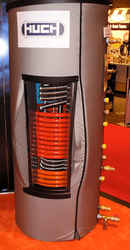Stainless may be an overkill if you plan on a closed loop system. Once all the air is purged and the system heats and drives off all the microbubbles there should be no corrosion going on. You could always add an inhibitor, either a hydronic specific chemical, or just an O2 scavenger like the open system OWF people sell.
The bigger challenge comes with the HX. If you want a tank with internal heat exchangers the price goes up quickly. Most, even steel ones, are designed for DHW use and are glass or stone lined. But for just a buffer for boiler fluid a plain steel tank should be fine.
If money wasn't an object I would own one of the tanks in this pic. They are commonly used in Europe. This tank has three internal coils for solar, wood, supplemental inputs or take off and it contains the DHW. It really simplifies the piping and need for three way divertor valves. I've heard around 4 grand for this 1000L tank. But that's not a lot of buffer or storage capacity.
I currently have a 500 gallon LP tank matched to my 40KW EKO. I'd like a bit more capacity for longer off cycles. Even with a small design load of 32,000 BTU/ hr for my shop and office, 8- 12 hours of time is all it buys me.
Like buying a truck, tool, or any equipment.. You need to decide how nice you want and what you are willing to spend to get there.
When I do find an additional LP tank to add to mine, I'm going to try wrapping some copper coils around the outside for heat exchangers. The Rheem/ Rudd Solaraide tank is built that way. You don't get quite the exchange as an internal coil, but it would be easy to field build and repair or replace.
I bought a bunch of copper solar panel absorbers from
www.thermafin.com to use as my external HX to maximize the surface area.
So much to do so little time.
My advice when designing you system is to do a lot of math first. It's cheap and easy and the formulas are readily available.
First insulate your buildings as best you can. By far the best place to spend money. Lower the load to the smallest possible number.
Next a room by room heat load calc.
Then select heat emitters that can operate at the lowest possible temperature. Often radiant floors are the winners. Unless you plan on a lot of carpeting

By designing around the lowest possible supply temperature you can leverage thermal solar. A solar panel, like a boiler will deliver the highest efficiency with the lower return temperature. Use and leverage the delta T. If you can charge a storage to 140, 160, or even 180, and drawn down to 90- 100F you have a huge delta t to work with.
If money allows weather responsive controls are nice. They allow the supply temperatures to change as the load does. Never overshooting, always trying to match the heat supplied exactly to the heat loss of the building, and with the lowest supply temperatures. Plenty of outdoor reset options available these days.
There are a bunch or really nice mixing assemblies showing up from Europe. PAW has some variable speed pump modules to both charge and unload your buffer. Solar pump modules that can watch east and west facing panels, and charge one or two tanks on priority, to let's say handle you DHW load first, then charge the heating side. All from one digital control. These plug and play modules take a lot of the guess work and experimenting out of your design. Sometimes money well spent.
A bit long winded but it may help you in the planning stage.
hr



